
 |
Tea Clipper |
 |
| from TeaAntiques.com | ||
| Edition One Hundred and Eight |
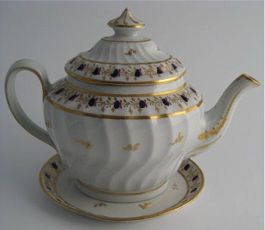
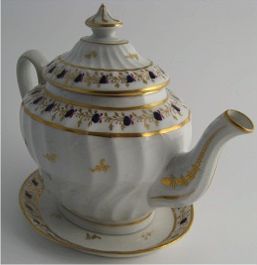 A
charming New Hall teapot and stand, c1795-1800. The teapot and stand are decorated
with a blue, pink and gilt floral border, pattern number 202.
A
charming New Hall teapot and stand, c1795-1800. The teapot and stand are decorated
with a blue, pink and gilt floral border, pattern number 202.
The body of the teapot is of an oval waisted shanked (spiral fluted moulded lines) shape, very fashionable in England at the end of the Eighteenth century. The cover and stand are also shanked moulded.
The body of the teapot has a delightful enamel band of floral decoration on the shoulder in the form of blue and pink flowers linked with very fine gilded foliage. This decoration runs round the shoulder of the teapot between two thick gilded lines.
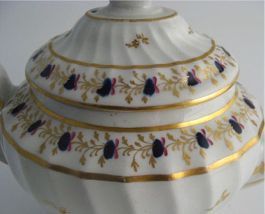
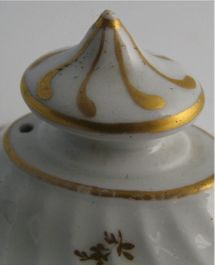
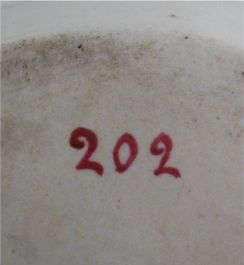
The underside of the teapot and stand are marked with the pattern number 202 in pink.
More details of this item and other tea related antiques can be found by visiting my web site at www.TeaAntiques.com.
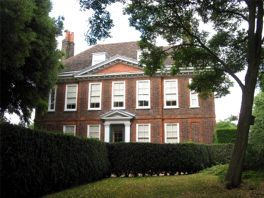
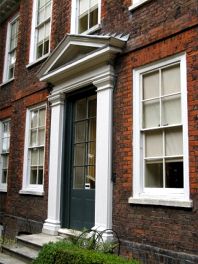 Surprisingly
near to the centre of London, although retaining a village atmosphere, is Hampstead.
Perched on the edge of Hampstead Heath, Hampstead is on high ground and from parts
of the Heath there are staggering views across to the heart of London dominated
by the city skyscraper buildings, but also visible the much older buildings including
St Paul's Cathedral. Nestled on the hills of Hampstead is the most charming old
Fenton House.
Surprisingly
near to the centre of London, although retaining a village atmosphere, is Hampstead.
Perched on the edge of Hampstead Heath, Hampstead is on high ground and from parts
of the Heath there are staggering views across to the heart of London dominated
by the city skyscraper buildings, but also visible the much older buildings including
St Paul's Cathedral. Nestled on the hills of Hampstead is the most charming old
Fenton House.Fenton is a late seventeenth century house that was probably built by a master bricklayer or carpenter, rather than one of the more fashionable London architects of the period. Houses in this area would probably have been owned by people from the wealthy merchant or professional classes. Some of the earliest inhabitants of Fenton were lawyers by profession. Later it became the home of Linen merchants, tobacco importers and such like.
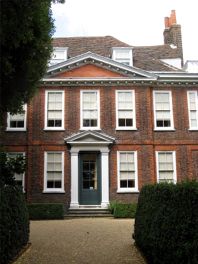 Today,
most visitors to Fenton approach the house via Holly Hill and the entrance to the
house is marked by a beautiful wrought iron gate which bears the initials of Joshua
Gee together with his wife Anna. The quality of the craftsmanship in the making
of these gates is second to none.
Today,
most visitors to Fenton approach the house via Holly Hill and the entrance to the
house is marked by a beautiful wrought iron gate which bears the initials of Joshua
Gee together with his wife Anna. The quality of the craftsmanship in the making
of these gates is second to none.
Making your way up the path the house shows its perfect symmetry of design, having a red brick front, with a break front surmounted by a triangular pediment. Today, we enter the house to the side on the East Front. Here there is a colonnaded porch positioned between the protruding red brick wings of the house. This porch was probably added sometime after 1807 by James Fenton, son of a Yorkshire Baltic Merchant.
The door under the porch has always been the main front entrance to the house, it being much nearer to the road and so more convenient. Above the porch is a white disc where once there was a clock. Indeed this house was known as Clock House from c1760 to sometime in the nineteenth century.
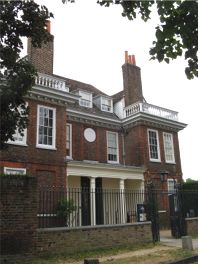
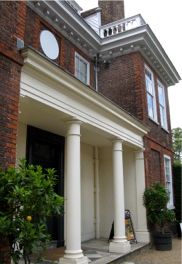
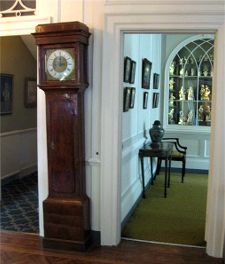 The
Hall leads straight though the house on the ground floor, and from this Hall leads
a wooden staircase to the right for access to the floors above. The Hall retains
some of its original seventeenth century panelling.
The
Hall leads straight though the house on the ground floor, and from this Hall leads
a wooden staircase to the right for access to the floors above. The Hall retains
some of its original seventeenth century panelling.
To the left as you enter the Hall is the Dining Room. Originally this was two rooms with a corner closet. Today is is one large room. One of the things that Fenton is now renowned is for its superb collection of early Keyboard instruments. Many of which are played from time to time in small gathering concerts. This room houses one of the harpsichords c1770, as well as the dining room furniture.
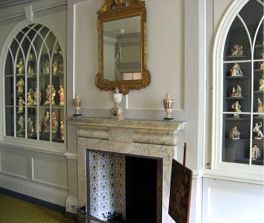 Two
other rooms on this floor are the Porcelain Room and the Oriental Room. The Porcelain
Room has over many years changed its function and has been referred to as the Small
Smoking Room, Study and Sitting Room. Clearly, it is now known as the Porcelain
room owing to a fine collection of early porcelain figures displayed in two glass
fronted built in cabinets either side of the marble fireplace. Many of these figures
are from the great Meissen factory of the Eighteenth century and include figures
such as that of Harlequin, designed as a table decoration. There are other continental
and English factories represented here too. Information boards are available to
give information about each of the items displayed. this impressive collection belonged
to Lady Binning 1937-9. This room houses another early keyboard instrument, a Ruckers
harpsichord, c1612.
Two
other rooms on this floor are the Porcelain Room and the Oriental Room. The Porcelain
Room has over many years changed its function and has been referred to as the Small
Smoking Room, Study and Sitting Room. Clearly, it is now known as the Porcelain
room owing to a fine collection of early porcelain figures displayed in two glass
fronted built in cabinets either side of the marble fireplace. Many of these figures
are from the great Meissen factory of the Eighteenth century and include figures
such as that of Harlequin, designed as a table decoration. There are other continental
and English factories represented here too. Information boards are available to
give information about each of the items displayed. this impressive collection belonged
to Lady Binning 1937-9. This room houses another early keyboard instrument, a Ruckers
harpsichord, c1612.
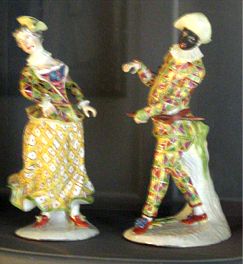
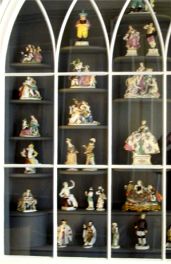
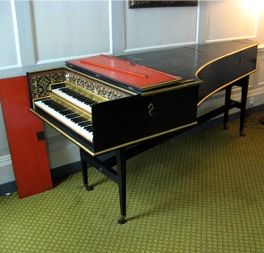
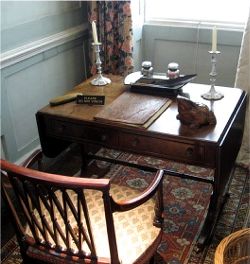
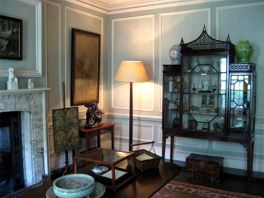 Opposite
the Porcelain Room is the Oriental Room. This room was used by Lady Binning as her
Library. The room has a corner closet, now open as part of the room, in which now
stands a writing table, actually a Georgian sofa table with a drop leaf at each
end. The room contains more of Lady Binning's collection; this time in the form
of Oriental porcelain which she collected in the 1920's and 30's. Some of this collection
is housed in a Chinese Chippendale style cabinet and include pieces from the Song,
Jiajung and Kangxi dynasties. However, I did spot in a small wall mounted cabinet
in the closet, a few items of Worcester blue and white porcelain, including a tea
canister and tea bowls and saucer, c1770.
Opposite
the Porcelain Room is the Oriental Room. This room was used by Lady Binning as her
Library. The room has a corner closet, now open as part of the room, in which now
stands a writing table, actually a Georgian sofa table with a drop leaf at each
end. The room contains more of Lady Binning's collection; this time in the form
of Oriental porcelain which she collected in the 1920's and 30's. Some of this collection
is housed in a Chinese Chippendale style cabinet and include pieces from the Song,
Jiajung and Kangxi dynasties. However, I did spot in a small wall mounted cabinet
in the closet, a few items of Worcester blue and white porcelain, including a tea
canister and tea bowls and saucer, c1770.
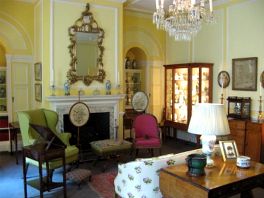
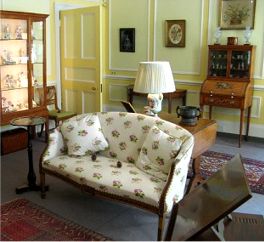 Making
your way up the stairs, with its original turned Seventeenth century balusters,
to the 1st floor landing from which are accessed four more rooms. Straight ahead
of you is firstly the very pretty Drawing Room, elegantly decorated and furnished
in yellow tones by John Fowler in 1973. This is indeed a most comfortable and light
looking room, very much a Ladies' Drawing Room. Apart from the elegant settees,
chairs and satinwood furniture much of which is in the style of Sheraton, there
are display cabinets in which are some beautiful items of porcelain. There are charming
Eighteenth tea wares from the Worcester factory, including a fine blue ground teaset
painted with the Worcester 'fancy birds' and another set with a green ground and
decorated with fruit and flowers, c1770.
Making
your way up the stairs, with its original turned Seventeenth century balusters,
to the 1st floor landing from which are accessed four more rooms. Straight ahead
of you is firstly the very pretty Drawing Room, elegantly decorated and furnished
in yellow tones by John Fowler in 1973. This is indeed a most comfortable and light
looking room, very much a Ladies' Drawing Room. Apart from the elegant settees,
chairs and satinwood furniture much of which is in the style of Sheraton, there
are display cabinets in which are some beautiful items of porcelain. There are charming
Eighteenth tea wares from the Worcester factory, including a fine blue ground teaset
painted with the Worcester 'fancy birds' and another set with a green ground and
decorated with fruit and flowers, c1770.
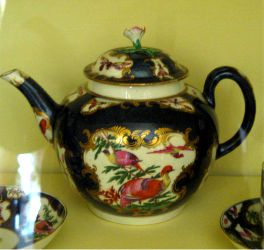
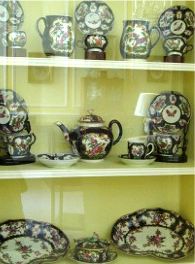
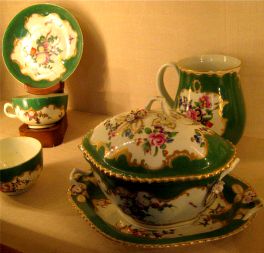
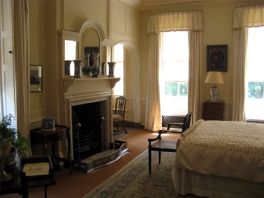
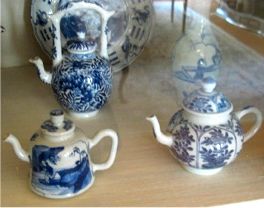 At
the front of the house is the Blue Porcelain Room and Rockingham Room. The
Blue Porcelain Room was once the bedroom of Lady Binning. Today it displays a large
collection of oriental blue and white porcelain. Like other rooms there would have
been a separate corner closet, used in the Eighteenth century for powdering wigs
etc. This now forms part of the room. There is a wide arch supported by two large
columns, this denotes where there was once probably a wall, giving a separate passage
to the mechanics of the clock in the house wall. Behind this grand archway are now
wall cabinets crammed with more blue and white porcelain, much of which is from
the Kangxi dynasty (1662-1722). Such porcelain was being imported by the Dutch East
India Company to supply the market of European collectors.
At
the front of the house is the Blue Porcelain Room and Rockingham Room. The
Blue Porcelain Room was once the bedroom of Lady Binning. Today it displays a large
collection of oriental blue and white porcelain. Like other rooms there would have
been a separate corner closet, used in the Eighteenth century for powdering wigs
etc. This now forms part of the room. There is a wide arch supported by two large
columns, this denotes where there was once probably a wall, giving a separate passage
to the mechanics of the clock in the house wall. Behind this grand archway are now
wall cabinets crammed with more blue and white porcelain, much of which is from
the Kangxi dynasty (1662-1722). Such porcelain was being imported by the Dutch East
India Company to supply the market of European collectors.
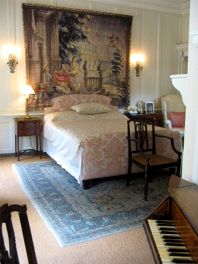
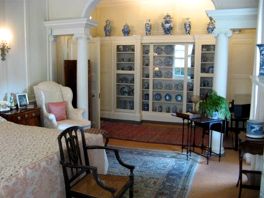
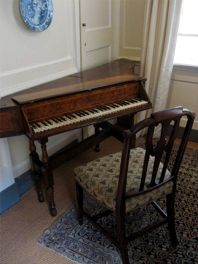
As with the other rooms in this house, there are more early keyboard instruments in the Blue Porcelain Room. There is a charming little spinet, made in London during the first half of the Eighteenth century and an early seventeenth century Italian virginals.
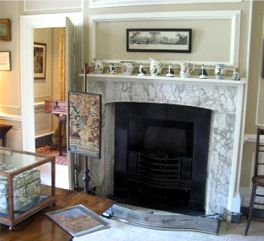 The
Rockingham Room, as it is now referred to for its collection of Rockingham porcelain,
was originally a bedroom with closet. There is a collection of animal figures from
the Rockingham factory, together with some pieces from Chelsea and Bow and include
hunting stirrup cups in the shape of hunting hounds. There are also Prattware jugs
on the fireplace mantel piece. One of the musical instrument in this room is a Shudi
single manual harpsichord c1761 and in the closet a Marcus Siculus virginals c1540.
The
Rockingham Room, as it is now referred to for its collection of Rockingham porcelain,
was originally a bedroom with closet. There is a collection of animal figures from
the Rockingham factory, together with some pieces from Chelsea and Bow and include
hunting stirrup cups in the shape of hunting hounds. There are also Prattware jugs
on the fireplace mantel piece. One of the musical instrument in this room is a Shudi
single manual harpsichord c1761 and in the closet a Marcus Siculus virginals c1540.
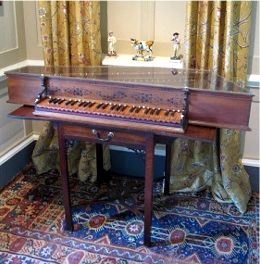
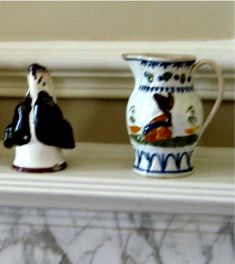
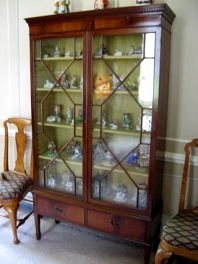
Opposite the Drawing Room at the back of the house is the Green Room, once a further bedroom and separate closet. In this room is a green upholstered camel back settee c1720 and a very handsome walnut chest on stand, c1700, there is a Dutch style wall mounted cabinet containing more items of miscellaneous porcelain. On the fire mantel piece is an Eighteenth century Prattware tea canister.
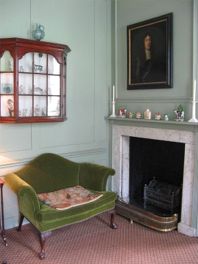
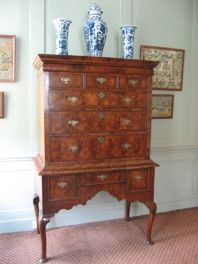
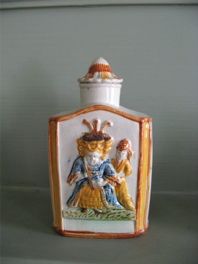
The second floor (or attic floor) of the house contains six garret rooms, each again containing some fine early keyboard instruments. It is worth noting that from the South East and East Rooms, there are some fine views of the city of London.
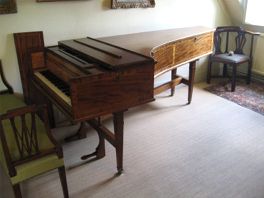
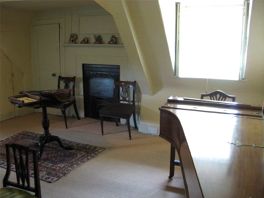
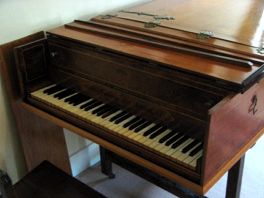
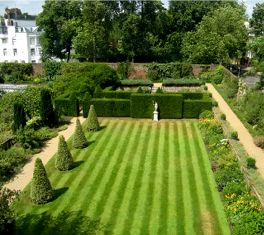
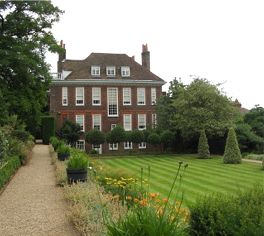 The
garden of Fenton House is a little treasure, beautifully planted in areas, or rooms,
and includes at the lower part a vegetable garden and old orchard. Essentially,
the National Trust has done a lot of work in the garden to create a typically English
style garden, which is full of interest with vistas, statues and good planting schemes.
The use of finely clipped Yew hedging gives the garden a fine formal structure and
gives a perfect foil for the bright summer colours of the borders.
The
garden of Fenton House is a little treasure, beautifully planted in areas, or rooms,
and includes at the lower part a vegetable garden and old orchard. Essentially,
the National Trust has done a lot of work in the garden to create a typically English
style garden, which is full of interest with vistas, statues and good planting schemes.
The use of finely clipped Yew hedging gives the garden a fine formal structure and
gives a perfect foil for the bright summer colours of the borders.
Fenton House is a beautiful house and very pleasant garden to enjoy - not too far from the hustle and bustle of the city of London. Combined with a stroll round the Heath and maybe a visit to nearby Kenwood House, which contains some very fine Robert Adam decoration, it can make a perfect whole day's excursion.
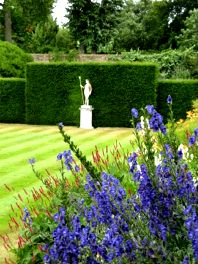
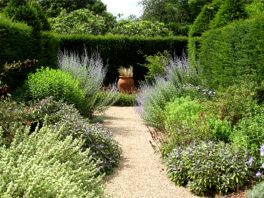
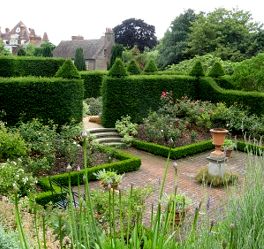
Unfortunately, Fenton House does not have a tea room, but I can recommend a short walk to Burgh House, a similar fine red brick house, which not only has exhibitions on the history of Hampstead village and the Heath, but also has a charming tea room for lunches and tea.
Fenton House, Windmill Hill, Hampstead, London, NW3 6RT http://www.nationaltrust.org.uk/main/w-fentonhouse tel: 020 7435 3471.
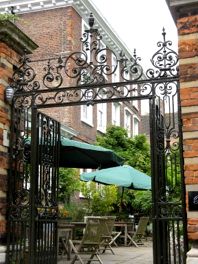
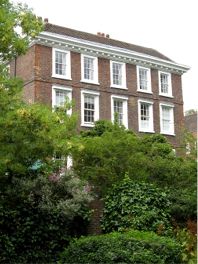 A
short walk from Fenton House is Burgh House and Hampstead Museum. Here there is
an opportunity to find out a little of the history of the Hampstead area and also,
there is 'The Buttery Café' in which to enjoy afternoon tea. As well as an indoor
area, they also serve tea in the front garden of the house, at tables with parasols.
A really pleasant surrounding in which to partake of tea. I took my afternoon tea
here with one of their very nice home-made fruit scones with clotted cream and jam.
A restful and very tasty way to complete my afternoon in Hampstead.
A
short walk from Fenton House is Burgh House and Hampstead Museum. Here there is
an opportunity to find out a little of the history of the Hampstead area and also,
there is 'The Buttery Café' in which to enjoy afternoon tea. As well as an indoor
area, they also serve tea in the front garden of the house, at tables with parasols.
A really pleasant surrounding in which to partake of tea. I took my afternoon tea
here with one of their very nice home-made fruit scones with clotted cream and jam.
A restful and very tasty way to complete my afternoon in Hampstead.
The opening times are Tuesday - Friday 11am-5.30pm, weekends 9.30am-5.30pm.
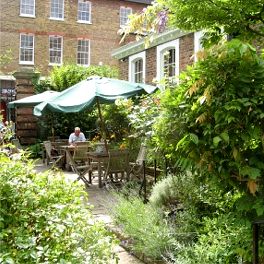
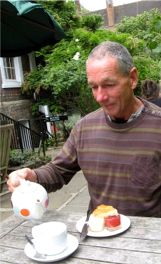
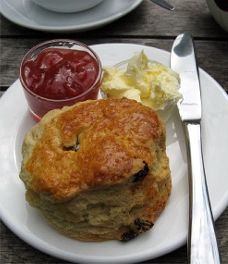
To review past newsletters, just follow this link:
Past newsletters.
To subscribe to this free newsletter -
Click here